Compartment 16 is the areas formerly occupied by the runway, taxiways, dispersal areas and ancillary buildings. It is 77.5 hectares in area, with no division into subcompartments. It, and the four intervening "lozenges" (compartments 9 to 12) together occupy the majority of the generally flat and level central plateau of the common.
Following the acquisition of the common by WBC, civil engineers Raymond Brown removed the majority of the concrete and tarmac, leaving the underlying gravels exposed and completely bare of vegetation. The only major area left untouched was the central cross of the runway and taxiways, which remains as a reminder of the cold war history. Between 1995 and 1999 the operation processed 1.3 m tonnes of material, the crushed concrete being used in the construction of the Newbury bypass. The excavations lowered the ground level of the former runway, relative to the surrounding land, by up to a metre. Some areas were infilled and re-modelled to create slopes, banks and mounds for habitat variety.
General description and evaluation of ecology
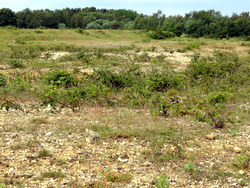
The previously bare gravels are now (2014) at varying stages of colonisation by pioneer communities and open ground annual species. Some areas still show significant amounts of bare ground, while others have developed into a closed sward grassland. Compartment 16 is therefore highly varied in terms of both the extent and type of vegetation cover. It is now best described as a mosaic of open ground and grassland, developing scrub and some heathland, all interspersed with both ephemeral and permanent water bodies.
Despite the gravel subsoils, winter waterlogging of the surface is widespread. Many of the barest areas are sparsely vegetated due to standing water present for weeks or months each winter. Vegetation development and ground cover have generally progressed further in the east than the west of the compartment. In many places, cover has developed to the extent that the boundaries with neighbouring compartments (which were never cleared back to bare ground) are no longer obvious.
The whole compartment is available for grazing by cattle and Exmoor ponies. The central runway cross (tarmac over concrete) is occasionally used for supplementary feeding of livestock in harsh weather.
Rare spring sedge, annual knawel, fine-leaved sandwort (all BAP species) and rue-leaved saxifrage exemplify the botanical interest of the open ground. Calcicolous species such as kidney vetch and dwarf thistle occur in base-rich areas where concrete fragments from the runway and taxiways were assimilated into the gravels. Kidney vetch in particular is important as the primary larval foodplant for the small blue butterfly, which is common in those places where the plant grows.Bryophyte communities are of particular note. Tendril-like mosses are prominent in the gravel areas together with a range of lichens of the genus Cladonia. Mosses of the genus Bryum and others are associated with ridges and piles of gravel. There are also some important calcicolous species within base-rich zones.
Northern lapwing (a BAP species), little ringed plover, ringed plover, meadow pipit and woodlark breed here or are regularly present, making this one of the most important areas of the common for ground-nesting birds. Thickets of dense scrub within and on the edges of the compartment also provide variation of habitat, nesting sites and cover.
Dark bush-cricket, long-winged conehead, meadow grasshopper, field grasshopper and mottled grasshopper are all present.
The perennial and ephemeral ponds and general wetland habitats provide a good deal of interest, some having pioneer species such as stoneworts and others in a more advanced state of colonisation with rushes, sedges such as common yellow sedge, and common spike rush at the margins, and aquatics such as broad-leaved pondweed. A good range of dragonflies, damselflies and other invertebrates breed in the ponds. Unfortunately the invasive New Zealand pigmyweed Crassula helmsii is widespread within the ponds.
BAP habitats
- Open mosaic habitats on previously developed land
- Ponds
Higher Level Stewardship
Options exist for parts of the compartment
- HK7 (restoration of species-rich semi natural grassland)
- HO2 (restoration of heathland from a neglected site)
Overall management objectives
Arrest or reset succession to maintain open bare areas for thermophilous invertebrates and ground nesting birds. Concentrate on areas with or adjacent to existing bare ground, and sunny slopes. Aim for bare or sparsely vegetated ground on all scales from centimetres to tens of metres. Allow other areas to develop as grassland, heathland and scrub thickets for habitat variety. Monitor and where desirable control extent of brambles, gorse and other scrub.
Compartment 16 (77.5 ha)
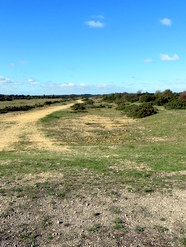
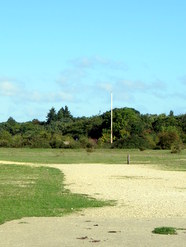
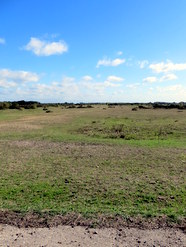
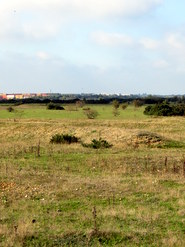
| Objective | Area | Method | Comment |
|---|---|---|---|
16.1) Reduce extent of gorse, bramble and other scrub.HLS objectives |
Throughout compartment. | Clear all gorse and scrub on south-facing slopes and selected stands elsewhere. Large areas by contractor with heavy machinery, smaller areas with hand tools, cut and collect mower or chainsaw. Remove litter layer where it is thick by scraping. Remove cuttings. Allow some stands to re-grow to diversify structure, elsewhere treat stumps or remove roots with machinery. | Refer to Gorse Management Plan (WBC 2012). |
16.2) Monitor heather establishment on gravels, repeat seeding if necessary.HLS objectives |
Heathland remnants in 16 East. | Monitor heather establishment and repeat seeding if necessary - collect material, using a cut and collect mower, from donor areas on the site and spread cuttings on recipient area. | |
| 16.3) Maintain open gravel areas. | Fireplane area and other key ground nesting bird areas. | Cut and remove scrub by weed-wiping, hand tools, chainsaw or cut and collect mower. Treat stumps.
Re-set succession on gravel areas. Scrape selected vegetated patches of gravel (c. 100 m2 of varying shapes) back to bare gravel. Remove turves from site and compost. Repeat annually on a 10 year rotation. Reduce corvid predation in wader nesting areas: Fell all high perch trees within 50 metres of the outermost edges of these areas. Retain scrub, leave cut timber in situ. |
Mark as 'red zones' during nesting season.
Large areas can be scraped by gorse-cutting contractor when working in this and adjacent compartments. Smaller areas can be scraped by volunteers etc. with hand tools. |